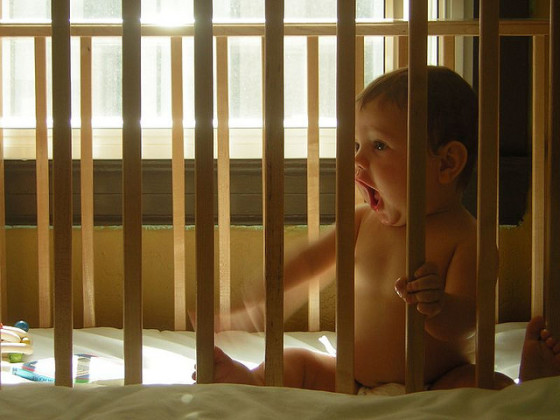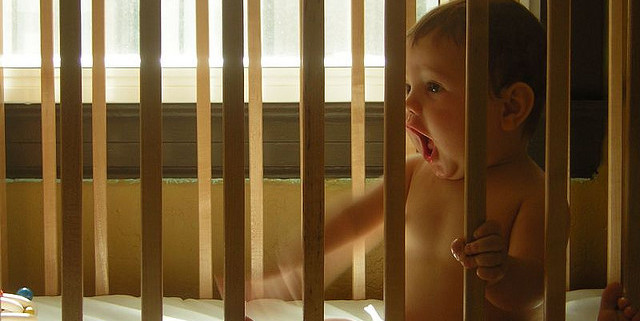Making Baby’s Crib Safe

Contents
Getting The Right Crib
The first step is getting the right crib. It should be sturdy and safe, without dangerous features that could injure your baby. Federal law governs safety standards for cribs, but there is always some leeway in the rules and not all manufacturers are fully compliant. When looking for a crib, consider these safety issues:
Sturdiness
Either in the store or after you’ve assembled the crib, push on it and shake it around. It should feel solid. If the crib rattles or feels flimsy, it’s not safe. It may be assembled incorrectly or it may simply be an unsafe design. Your little one will move around in the crib and it you don’t want it to collapse.
Bars And Posts
The bars on your child’s crib should be less than 2.5″ apart. If the gaps between the bars are wider than that, the child’s legs and body can slide through and trap the head, posing a suffocation or neck injury risk. If the bars are really far apart, the child may fall out of the crib entirely.
The posts at the corners of your child’s crib should be flush with the top of the rails. If the posts stick out, your child’s clothing may get caught on the post and trap or choke the child.
Size
The crib should snugly fit a standard crib mattress – 27 1/4″ x 51 5/8″ to 28″ x 52 3/8″. If the crib is too large for the mattress, your child can get stuck in the gap between the mattress and the edge of the crib.
Adjustability
Many cribs have adjustable bases to make it easier for you to bend down and pick up your baby. Make sure the crib height is set so that your little one can’t climb over the sides.
Some older cribs have drop sides, but this is now considered unsafe. The drop sides can come loose over time and fall on their own, trapping the child or allowing the child to fall out of the crib.
Decoration
Some cribs have decorative elements such as carvings and patterns on the bars and frame. If you choose a crib with decorative elements, make sure that those pieces can’t break off and create a choking hazard.
Age
Many families have old cribs and other furniture that have been passed down for generations. While these heirlooms are important to you, they’re not safe for the baby. Old cribs may have worn out, making them prone to collapse. They may contain dangerous materials such as lead-based paint or toxic wood varnish that can hurt your baby. They’re also not in line with the most up-to-date safety standards.
Where To Put The Crib
Some families choose to keep the crib in the master bedroom while others create a separate room for the baby. Either is fine; it’s a matter of what works best for you. Wherever you put the crib, make sure it’s away from the windows. The cords on the blinds and the curtains are a choking hazard and can also give your child a means to stand up and get out of the crib.
What Should Be In The Crib?
Now that you’ve chosen and positioned your crib, what should you put into it? Your baby and nothing else! Babies are safest in empty cribs.
While sleeping, babies are at risk for suffocation. This is especially true for children under 6 months of age. Babies aren’t as mobile as adults and can’t free themselves easily if they get their faces buried in blankets, stuffed animals, or anything else in the crib. A fitted sheet can protect the mattress and isn’t a risk for the baby, but blankets can cause your little one to suffocate. If you’re worried about the temperature in the room, it’s safer to dress your little one in warm pajamas.
We’re not comfortable sleeping without pillows, but babies are. Their bodies are different and they have different needs. They’re safest sleeping on their backs with no pillow.
Like blankets and pillows, toys in the crib are dangerous. Soft toys can smother the baby and hard ones may cause injury if the child moves around.
Crib bumpers are similarly dangerous. Crib bumpers are long, soft pillows designed to go around the edge of the baby’s mattress to block any gap between the crib and the mattress and prevent the baby from rolling into the side of the crib. They were popular for decades, but are now known to create a suffocation hazard.
You may want to leave a baby monitor near the crib, but babies can injure themselves with the cords. Choose a cordless monitor or keep the monitor and its cords well out of baby’s reach.
Sleep Safely!
As you prepare to welcome your new baby into the world, keep safety at the top of your mind. Your baby will spend a lot of time in the crib, so it’s worth your time to make sure it’s as safe as possible.
Image Credit and License








Leave a Reply
Want to join the discussion?Feel free to contribute!